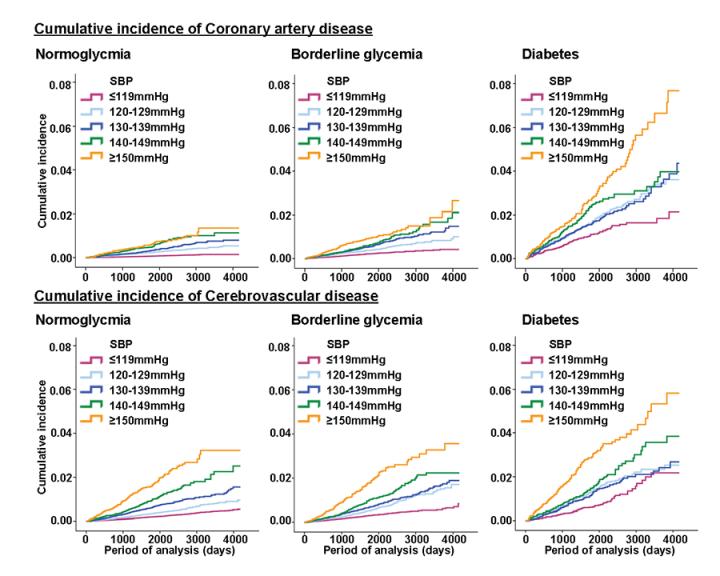Provides insight on what blood pressure targets in patients with hypertension according to glucose status should be
Niigata, Japan – An estimated 1.13 billion people worldwide have hypertension or high blood pressure, and two-thirds of these individuals are living in low- and middle-income countries. Blood pressure is the force manifested by circulating blood against the walls of the body’s arteries, the major blood vessels in the body. Hypertension is when blood pressure is too high.
Blood pressure is written as two numbers. The first (systolic) number represents the pressure in blood vessels when the heart contracts or beats. The second (diastolic) number represents the pressure in the vessels when the heart rests between beats. Hypertension is diagnosed if, when it is measured on two different days, the systolic blood pressure (SBP) readings on both days is ≥140 mmHg and/or the diastolic blood pressure (DBP) readings on both days is ≥90 mmHg.
Worldwide, high blood pressure is a common and strong risk factor for the development of cardiovascular disease. As reported by previous studies in Asia and elsewhere, as the level of SBP rises, the risk of developing cardiovascular disease increases, too. Similarly, the likelihood of dying from a cardiovascular event increases as the SBP rises. However, whether these observations hold for increases in DBP is not known. Moreover, although a high blood glucose status is itself associated with a high likelihood for the development of cardiovascular disease, it is not known whether the blood glucose status plays any role in the relationship between high blood pressure and cardiovascular events.
This theory led the authors to propose a hypothesis for their study. Commenting further, Dr. Kazuya Fujihara of the Department of Internal Medicine, Faculty of Medicine, Niigata University, said “The 2017 American College of Cardiology (ACC)/American Heart Association (AHA) BP guideline defined blood pressure >130/80 mm Hg as hypertension. This guideline showed that the normal level is less than 120/80 mm Hg and SBP 120-129 mm Hg and DBP
In the Diabetes Care paper, the authors addressed these research questions using a nationwide claims-based database that included information on 805,992 people enrolled with a health insurance provider for company employees and their dependents in Japan. In one arm of the study, they compared the cumulative incidence of coronary artery disease according to their SBP in individuals with normal, borderline and elevated blood glucose, separately (Figure). The authors reported that, “a linear relationship was observed between cumulative incidence rates of coronary artery disease and SBP categories across all glucose tolerance status designations using SBP below 119 mmHg as the reference”. In another arm of the study, the investigators compared the cumulative incidence of cerebrovascular disease according to their SBP in individuals with normal, borderline and elevated blood glucose, separately (Figure). Similarly, the authors observed a linear dose-response relationship between cumulative incidence rates of cerebrovascular disease and SBP categories across all glucose tolerance status. Furthermore, the investigators repeated similar analyses using the DBP and reported that “Similar to the relationship between SBP and coronary artery disease and cerebrovascular disease; the coronary artery disease and cerebrovascular disease risk concurrently increased with higher DBP categories”.
The study also found that combined together, the blood glucose status and blood pressure values had a synergistic effect on the incidence of coronary artery disease and cerebrovascular disease. Commenting on the significance of their findings, Prof. Sone said, “Compared to Westerners, Asians have significantly less coronary artery disease, but more stroke. In addition, Asians have a much lower obesity level than Westerners, and the pathogenesis of diabetes mellitus is also very different between the two. Therefore, this data should be an important reference for determining blood pressure thresholds for guidelines for Asians”. Commenting further, Dr. Fujihara said “Recent study [the Systolic Blood Pressure Intervention Trial (SPRINT) Final Report] showed that intensive treatment (SBP,
While the findings of these analytical study are impressive and provide new insight on what blood pressure targets in patients with hypertension according to glucose status should be, the authors recommended that “Further trials to examine strict BP interventions for preventing cardiovascular diseases should focus on patients with borderline glycemia and diabetes to confirm findings from the current cohort study and apply them to clinical practice”.
###
See the article: Yamada MH, Fujihara K, Kodama S, Sato T, Osawa T, Yaguchi Y, Yamamoto M, Kitazawa M, Matsubayashi Y, Yamada T, Seida H, Ogawa W, Sone H. Associations of Systolic Blood Pressure and Diastolic Blood Pressure With the Incidence of Coronary Artery Disease or Cerebrovascular Disease According to Glucose Status. Diabetes Care. 2021 May 25:dc202252. doi: 10.2337/dc20-2252. Epub ahead of print. PMID: 34035075.
Media Contact
Kazuya Fujihara
[email protected]
Original Source
https:/
Related Journal Article
http://dx.





